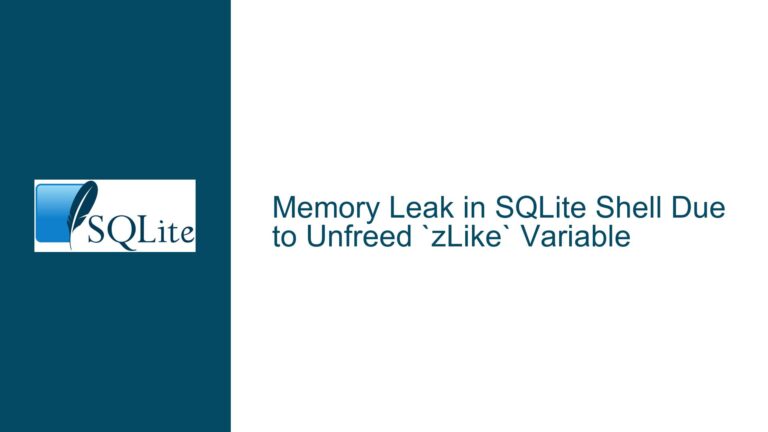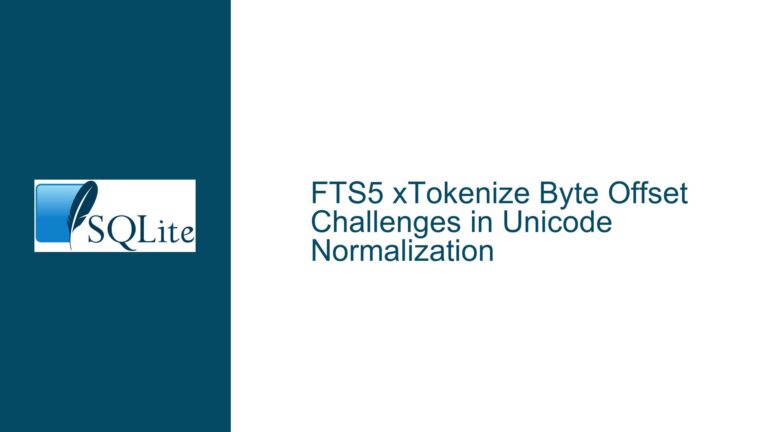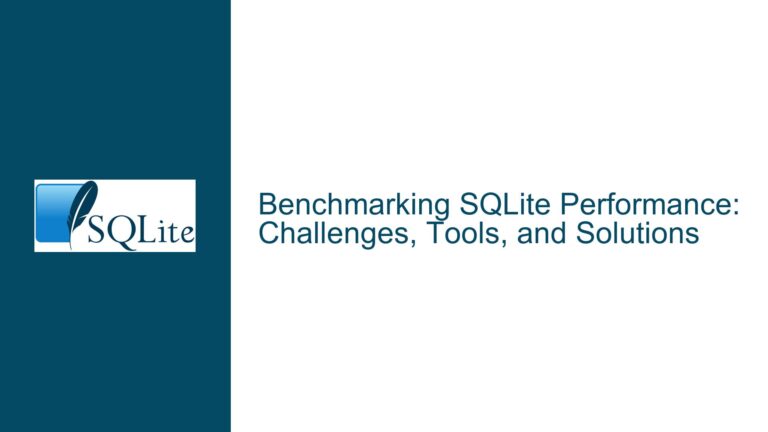Automatic Index Not Created in SQLite 3.43 with Co-Routine Usage
Automatic Index Creation Behavior in SQLite 3.43 vs. 3.39
In SQLite, automatic indexing is a feature designed to improve query performance by creating temporary indexes on-the-fly when the query planner determines that such an index would be beneficial. This feature is particularly useful for queries involving joins or subqueries where the absence of an index would lead to full table scans, resulting in significant performance degradation. However, in SQLite version 3.43, a regression has been observed where automatic indexes are not being created in certain scenarios involving co-routines, specifically when a subquery is used in conjunction with a LEFT JOIN. This behavior contrasts with SQLite version 3.39, where automatic indexing functions as expected under the same conditions.
The issue manifests when executing a query that involves a subquery with a GROUP BY clause, followed by a LEFT JOIN on another table. In SQLite 3.39, the query planner correctly identifies the need for an automatic index on the joined column and creates one, leading to a more efficient query execution plan. In SQLite 3.43, however, the query planner fails to create the automatic index, resulting in a full table scan and significantly slower query performance. This regression is particularly problematic for queries involving large datasets, where the absence of an index can lead to execution times that are orders of magnitude slower.
To illustrate the issue, consider the following query:
CREATE TABLE x(i integer, j);
CREATE TABLE y(i integer, j);
EXPLAIN QUERY PLAN SELECT * FROM (SELECT i, sum(j) AS t FROM x GROUP BY i) s LEFT JOIN y ON y.i = s.i;
In SQLite 3.39, the query plan includes the creation of an automatic covering index on table y for the join condition y.i = s.i. However, in SQLite 3.43, the query plan shows a full table scan on y instead of utilizing an automatic index. This discrepancy highlights a significant change in the query planner’s behavior between the two versions.
Factors Contributing to the Absence of Automatic Indexing in SQLite 3.43
Several factors may contribute to the observed regression in automatic index creation in SQLite 3.43. One possible cause is changes in the query planner’s cost estimation logic. The query planner in SQLite relies on cost-based heuristics to determine whether creating an automatic index would be beneficial. If the estimated cost of creating and using the index exceeds the cost of performing a full table scan, the planner may opt not to create the index. In SQLite 3.43, it is possible that the cost estimation logic has been adjusted in a way that disfavors automatic indexing in scenarios involving co-routines.
Another potential factor is the interaction between co-routines and automatic indexing. Co-routines in SQLite are used to optimize the execution of subqueries by allowing them to yield intermediate results incrementally. This optimization can reduce memory usage and improve performance for certain types of queries. However, it is possible that the introduction of co-routines in the query plan interferes with the query planner’s ability to recognize the need for an automatic index. Specifically, the planner may fail to account for the benefits of indexing when the subquery results are produced incrementally rather than materialized all at once.
Additionally, the presence of the ANALYZE command and the statistics collected by it may play a role in the query planner’s decision-making process. The ANALYZE command gathers statistical information about the distribution of data in tables and indexes, which the query planner uses to make informed decisions about query execution. If the statistics are not sufficiently detailed or if the query planner misinterprets them, it may lead to suboptimal decisions regarding automatic indexing. In the provided example, running ANALYZE does not resolve the issue, suggesting that the problem lies elsewhere in the query planner’s logic.
Finally, it is worth considering the possibility of a bug or unintended side effect introduced in SQLite 3.43. While SQLite is known for its robustness and thorough testing, regressions can occasionally occur, especially in complex areas such as the query planner. The observed behavior may be the result of a specific change in the codebase that inadvertently affected automatic indexing in certain scenarios.
Resolving the Automatic Indexing Issue in SQLite 3.43
To address the issue of automatic indexing not being created in SQLite 3.43, several troubleshooting steps and potential solutions can be employed. The first step is to verify the behavior by running the query in both SQLite 3.39 and SQLite 3.43 and comparing the query plans. This will confirm whether the issue is indeed a regression and provide insight into the specific changes in the query planner’s behavior.
If the issue is confirmed, the next step is to manually create an index on the joined column to determine whether it resolves the performance problem. In the provided example, creating an index on y.i would likely result in a significant improvement in query performance, as demonstrated by the reduction in execution time from 8 seconds to 0.03 seconds. While this approach is effective, it requires manual intervention and may not be practical in all scenarios, especially in applications where queries are dynamically generated.
Another potential solution is to adjust the query structure to encourage the query planner to create an automatic index. For example, rewriting the query to avoid the use of a co-routine or restructuring the subquery may influence the planner’s decision-making process. However, this approach requires a deep understanding of the query planner’s behavior and may not always yield the desired results.
If the issue is determined to be a regression in SQLite 3.43, the most effective solution may be to revert to SQLite 3.39 or a later version where the issue has been resolved. Alternatively, if the regression is confirmed to be a bug, it may be possible to apply a patch or workaround provided by the SQLite development team. Monitoring the SQLite mailing list or issue tracker for updates on the issue is recommended.
In cases where reverting to an older version is not feasible, or if the issue persists across multiple versions, it may be necessary to implement a custom solution. This could involve using application-level logic to manage indexing or employing a different database system that better meets the application’s requirements. However, such measures should be considered only after exhausting all other options, as they introduce additional complexity and potential maintenance overhead.
In conclusion, the absence of automatic indexing in SQLite 3.43 when using co-routines is a significant issue that can lead to degraded query performance. By understanding the factors contributing to the issue and employing appropriate troubleshooting steps and solutions, it is possible to mitigate the impact and ensure optimal query execution.






